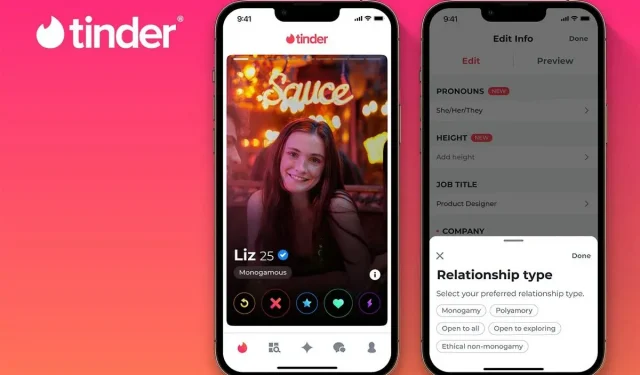Tinder allows for non-gendered pronouns and non-monogamous relationship types.

Tinder allows you to specify the different types of relationships you’re looking for. The app also allows you to define multiple pronouns in your profile.
This week, Tinder announced that its users can now add their desired relationship type and pronouns to their profile. For example, you can indicate that you’re looking for a monogamous or non-monogamous relationship (or that you’re not sure) and provide a gender pronoun of your choice. Both of these new features are borrowed from Hinge, owned by the same parent company that added these profile options last year.
Tinder lets you specify different types of relationships you’re looking for
New variations on the type of relationship desired are welcome as interest in this kind of research continues to grow, be it monogamy, ethical non-monogamy, open kin, polyamory, or “openness to research”. The company highlights a study conducted among 4,000 participants aged 18 to 25, which shows 41% of them are open or looking for a non-monogamous experience. Of these, open (36%) and hierarchical polyamorous (26%) relationships are among the most popular options. The survey also showed that 73% of young single people are looking for someone who knows what they want. Most of them do not want to waste time on a potential partner who has incompatible intentions.
The app also allows you to define multiple pronouns in your profile.
Similarly, the addition of pronouns to Tinder could be due to a survey showing that 33% of young people believe their sexuality has become more fluid over the past three years, while 29% believe their gender identity has become softer. In addition, the company explains that the LGBTQIA+ community is the fastest growing demographic group. In light of these revelations, Tinder now lets you choose up to four pronouns on your profile from 15 options.
These additions are in line with the relationship goals presented in the appendix last December. This option allows users to specify if they are looking for a short term relationship, a long term relationship, or something else. The company explains that 40% of its users who indicate their intent are looking for a long-term relationship, while 13% are looking for a short-term one. Either way, it shows that Tinder has evolved from the beginning and its reputation as a one-night stand.
The new features also come after Tinder’s parent company, Match Group, didn’t have a bright outlook as the company’s quarterly revenue fell for the first time. These options also align perfectly with Tinder’s latest “It all starts with a swipe”marketing campaign, which pitches the app as an adaptable experience for casual, no-obligation dates, but instead for strong, lasting relationships.
Leave a Reply